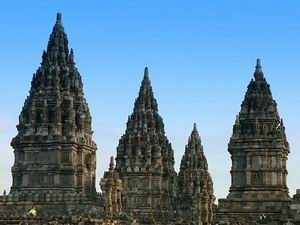The Restoration International of Prambanan Temple: Yogyakarta, Central Java
 When you travel by air from Bali to Yogyakarta in Central Java, you will inevitably see the massive Hindu temple complex of Prambanan.
When you travel by air from Bali to Yogyakarta in Central Java, you will inevitably see the massive Hindu temple complex of Prambanan.
If you travel by road from an easterly direction, you cannot miss it – Prambanan is only 100 metres from the road. Whichever way you first see this massive complex, its towering temple structures are awe-inspiring, and its beauty, breathtaking.
Built during the Sanjaya Dynasty in the 9th century, the central area has three main temples according to the Hindu Trinity – ‘Vishnu‘ facing to the North, ‘Shiva‘ in the centre, and ‘Brahma‘ to the South.
Unfortunately, the massive earthquake that struck the city of Yogyakarta a while ago not only damaged areas in the city itself, but it also affected the antiquities in the surrounding areas. Now, according to Tarko Sudiarno, some 100 experts from around the world are gathered in the city of Yogyakarta to discuss the restoration of the Prambanan Temple and the Yogyakarta palace complex:
The four-day meeting, organized by the United Nations Educational, Scientific and Cultural Organization (UNESCO), was opened Monday by the director general for archeological affairs at the State Ministry for Culture and Tourism, Hari Utomo Dradjat, at the Grand Mercure Hotel.
Among those attending the meeting are the chairman of the Indonesian National Committee for UNESCO, Arief Rahman, several UNESCO officials and the first secretary at the Japanese Embassy in Indonesia, Ahmad Katoah.
According to Hari Utomo Dradjat, the meeting will discuss the short-, medium- and long-term restoration strategies for Prambanan Temple and the Tamansari complex in the Yogyakarta palace, both of which were heavily damaged in the quake.
Arief Rahman said restoration work on Prambanan and Tamansari would involve archeologists, architects and geologists, keeping in mind the two sites are in an active quake zone.
According to Arief, the restoration work will not only focus on physically rebuilding the sites, but also on the social, cultural and religious aspects of the surrounding areas.
“We will consider the philosophical and religious aspects of the two sites, as well as the impact on the local economies,” he said.
Asked about funding for the renovation work, Hari said: “The required funds are ready, but I can’t tell you (how much it will cost). But the funds will come from both the government and the international community.”
Restoration work is expected to be partially funded by UNESCO and from foreign donations, including from Saudi Arabia, which has pledged US$25,000 for the work.
Dradjat said experts would conduct studies of the historical sites before handing over their findings for further discussion. The results of these talks will determine the strategies to be employed for the restoration work.